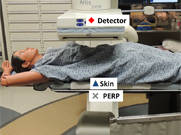Case 7: Patient Skin Dose with Interventional Fluoroscopy: Metrics, C-Arm Geometry and Spectral Filtration

CE and CME currently unavailable
Emphasizes awareness of skin dose during interventional fluoroscopy, use of metrics, C-arm geometry and special filtration to optimize dose.
Authors: W. Pavlicek; R.G. Paden; T. Boltz; J. Hanson
Target Audience: Radiologists, radiologic technologists and medical physicists working with interventional fluoroscopy
This educational activity is free.
Learning Objectives
Upon completion of this case, the participant will be able to:
- Identify the single most important tableside reported dose quality assurance (QA) metric for potential of skin tissue reactions, i.e. skin erythema
- Locate the patient exposure reference point (PERP) on the most commonly used interventional radiology (IR) C-arm configuration
- Utilize C-arm, table and detector geometry to minimize unnecessary skin dose to the patient
- Incorporate the use of spectral filtration, especially copper spectral filtration as a skin dose savings technique
- Identify the limitations of cumulative air kerma (CAK) as a surrogate for peak skin dose (PSD)